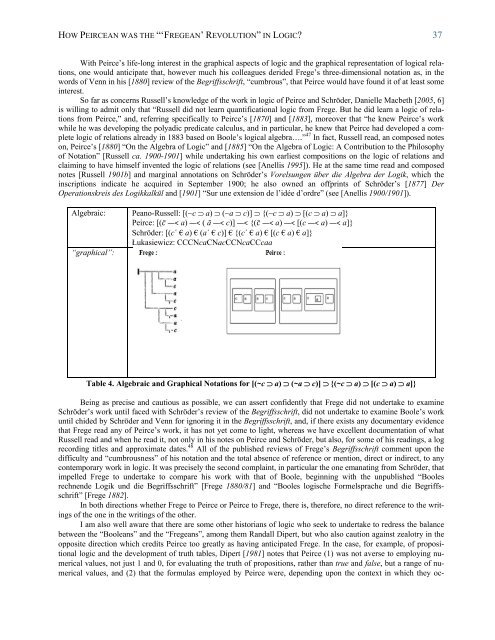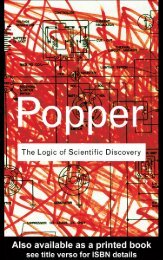Create successful ePaper yourself
Turn your PDF publications into a flip-book with our unique Google optimized e-Paper software.
HOW PEIRCEAN WAS THE “‘FREGEAN’ REVOLUTION” IN LOGIC? 37<br />
With Peirce’s life-long interest in the graphical aspects of logic and the graphical representation of logical relations,<br />
one would anticipate that, however much his colleagues derided Frege’s three-dimensional notation as, in the<br />
words of Venn in his [1880] review of the Begriffsschrift, “cumbrous”, that Peirce would have found it of at least some<br />
interest.<br />
So far as concerns Russell’s knowledge of the work in logic of Peirce and Schröder, Danielle Macbeth [2005, 6]<br />
is willing to admit only that “Russell did not learn quantificational logic from Frege. But he did learn a logic of relations<br />
from Peirce,” and, referring specifically to Peirce’s [1870] and [1883], moreover that “he knew Peirce’s work<br />
while he was developing the polyadic predicate calculus, and in particular, he knew that Peirce had developed a complete<br />
logic of relations already in 1883 based on Boole’s logical algebra….” 47 In fact, Russell read, an composed notes<br />
on, Peirce’s [1880] “On the Algebra of Logic” and [1885] “On the Algebra of Logic: A Contribution to the Philosophy<br />
of Notation” [Russell ca. 1900-1901] while undertaking his own earliest compositions on the logic of relations and<br />
claiming to have himself invented the logic of relations (see [Anellis 1995]). He at the same time read and composed<br />
notes [Russell 1901b] and marginal annotations on Schröder’s Vorelsungen über die Algebra der Logik, which the<br />
inscriptions indicate he acquired in September 1900; he also owned an offprints of Schröder’s [1877] Der<br />
Operationskreis des Logikkalkül and [1901] “Sur une extension de l’idée d’ordre” (see [Anellis 1900/1901]).<br />
Algebraic: Peano-Russell: [(~c � a) � (~a � c)] � {(~c � a) � [(c � a) � a]}<br />
Peirce: [(�� —< a) —< ( ā —< c)] —< {(�� —< a) —< [(c —< a) —< a]}<br />
Schröder: [(c´ € a) € (a´ € c)] € {(c´ € a) € [(c € a) € a]}<br />
Łukasiewicz: CCCNcaCNacCCNcaCCcaa<br />
“graphical”:<br />
Table 4. Algebraic and Graphical Notations for [(~c � a) � (~a � c)] � {(~c � a) � [(c � a) � a]}<br />
Being as precise and cautious as possible, we can assert confidently that Frege did not undertake to examine<br />
Schröder’s work until faced with Schröder’s review of the Begriffsschrift, did not undertake to examine Boole’s work<br />
until chided by Schröder and Venn for ignoring it in the Begriffsschrift, and, if there exists any documentary evidence<br />
that Frege read any of Peirce’s work, it has not yet come to light, whereas we have excellent documentation of what<br />
Russell read and when he read it, not only in his notes on Peirce and Schröder, but also, for some of his readings, a log<br />
recording titles and approximate dates. 48 All of the published reviews of Frege’s Begriffsschrift comment upon the<br />
difficulty and “cumbrousness” of his notation and the total absence of reference or mention, direct or indirect, to any<br />
contemporary work in logic. It was precisely the second complaint, in particular the one emanating from Schröder, that<br />
impelled Frege to undertake to compare his work with that of Boole, beginning with the unpublished “Booles<br />
rechnende Logik und die Begriffsschrift” [Frege 1880/81] and “Booles logische Formelsprache und die Begriffsschrift”<br />
[Frege 1882].<br />
In both directions whether Frege to Peirce or Peirce to Frege, there is, therefore, no direct reference to the writings<br />
of the one in the writings of the other.<br />
I am also well aware that there are some other historians of logic who seek to undertake to redress the balance<br />
between the “Booleans” and the “Fregeans”, among them Randall Dipert, but who also caution against zealotry in the<br />
opposite direction which credits Peirce too greatly as having anticipated Frege. In the case, for example, of propositional<br />
logic and the development of truth tables, Dipert [1981] notes that Peirce (1) was not averse to employing numerical<br />
values, not just 1 and 0, for evaluating the truth of propositions, rather than true and false, but a range of numerical<br />
values, and (2) that the formulas employed by Peirce were, depending upon the context in which they oc-





